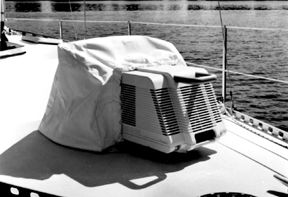Air conditioning aboard is seldom a problem when you’re plugged into shorepower. The difficulties arise when it gets hot and you’re underway. Your battery bank and inverter, which do such a nice job for your stereo and your lights, are just not up to the demands for 110-volt AC electricity that an air conditioner or other power-hungry large appliance requires.
The answer? An on-board generator set. A number of modest power output generator sets in sizes suitable for boats as small as 25′ to 30′ in length are available.
GENERAL CONSIDERATIONS
First, your choice of genset depends on the type of engine you use for propulsion. In other words, if you run your genset on the same type of fuel that you use for your main engine; this simplifies fuel storage, not to mention fueling-up. The same pros and cons of gas vs. diesel in general apply here: Gas engines are cheaper to buy, but cost more to run, are quieter but will give out sooner, etc. Most of the gensets covered in this article are powered by water-cooled engines.
Air-cooled diesel and gasoline generator sets are available, but, with few exceptions, these units are not intended for use on a boat. Some specialized air-cooled diesel engine-powered DC generator sets are available, usually in combination with direct mechanical power drive for such loads as refrigeration compressors and reverse osmosis watermakers. A few manufacturers also make small water-cooled DC generator sets which can be used to provide 100 amperes or more of 12-volt current, allowing operation of modest capacity air conditioners.
HOW BIG A GENSET?
Your first question should be: “Do I need a genset?” The answer is that you do if you run on-board air conditioning, or your boat has huge electrical demands. Otherwise, simplify your life, skip the plumbing and exhaust installations, and save (a great deal of) weight by going with an inverter instead. How big a genset your boat requires depends on the amount of electrical power needed. It is tempting to choose either too little or too much. On the side of too little is the obvious advantage of smaller size, weight, and cost. At the other extreme is the desire to simultaneously power every device on the boat. The best choice usually lies somewhere in between. A good starting point is to estimate your power requirements. Google search “electrical load calculator” or “estimating marine generator loads” and you come up with several sites with calculators that let you input your AC loads to come up with an approximation of peak loads.
Control of most modern, multi-unit, A/C systems can be coordinated to prevent simultaneous starting of compressors. This can be important, because the in-rush current required to start the compressor is a multiple of the running current. Load shedding – avoiding simultaneous use of the toaster, electric coffee pot, electric skillet, and hair dryer when all A/C systems are on – is an intelligent way to keep the maximum needed generating capacity within reason.
When sizing a genset, use the continuous kW rating of the genset rather than the peak kW or kVa rating.
For more advice on the selection and installation of a genset, check out Marine Electrical Systems, Vol. 5: AC Systems from Practical Sailor.










































